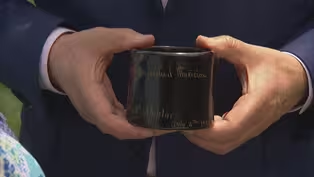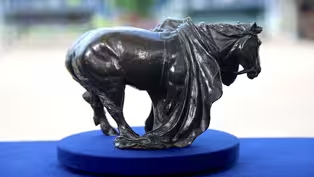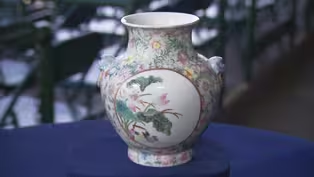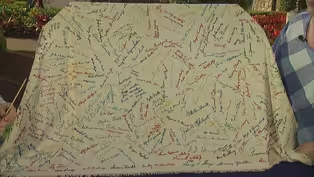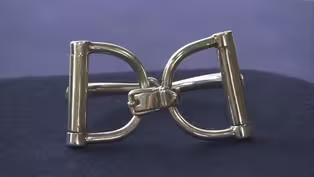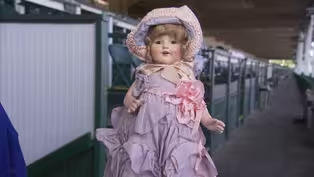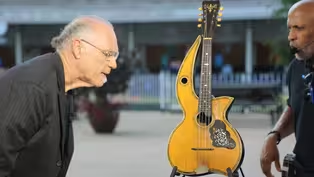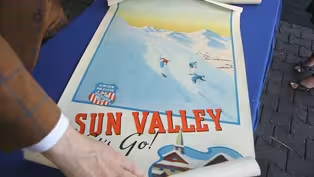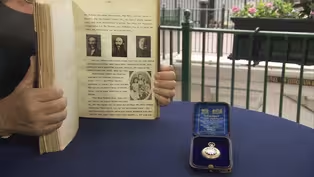
Churchill Downs Racetrack, Hour 2
Season 23 Episode 14 | 52m 29sVideo has Closed Captions
Discover first-place finds with ROADSHOW at Churchill Downs Racetrack.
Discover first-place finds with ANTIQUES ROADSHOW at Churchill Downs Racetrack, including a 1966 MGM Grinch figure, a Georgian & Victorian mourning jewelry collection, and a Larson Bros. symphonic harp mandolin. Which appraisal is $70,000-$90,000?
Problems playing video? | Closed Captioning Feedback
Problems playing video? | Closed Captioning Feedback
Funding for ANTIQUES ROADSHOW is provided by Ancestry and American Cruise Lines. Additional funding is provided by public television viewers.

Churchill Downs Racetrack, Hour 2
Season 23 Episode 14 | 52m 29sVideo has Closed Captions
Discover first-place finds with ANTIQUES ROADSHOW at Churchill Downs Racetrack, including a 1966 MGM Grinch figure, a Georgian & Victorian mourning jewelry collection, and a Larson Bros. symphonic harp mandolin. Which appraisal is $70,000-$90,000?
Problems playing video? | Closed Captioning Feedback
How to Watch Antiques Roadshow
Antiques Roadshow is available to stream on pbs.org and the free PBS App, available on iPhone, Apple TV, Android TV, Android smartphones, Amazon Fire TV, Amazon Fire Tablet, Roku, Samsung Smart TV, and Vizio.
Buy Now
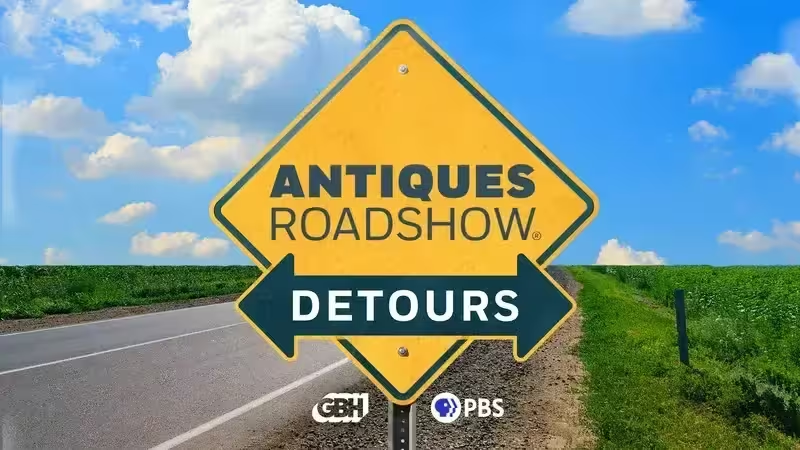
ANTIQUES ROADSHOW DETOURS
Ever wondered what happens to the treasures featured on America’s beloved ANTIQUES ROADSHOW after the cameras leave town? Host Adam Monahan tracks down the juicy afterlives of your favorite finds from PBS’s hit series.Providing Support for PBS.org
Learn Moreabout PBS online sponsorshipMARK WALBERG: "Antiques Roadshow" is champing at the bit to see thousands of treasures brought to Churchill Downs Racetrack in Louisville.
I never say mint, and this doll is mint.
Oh, my gosh!
(laughs): For my little frog!
♪ ♪ WALBERG: From the first Kentucky Derby in 1875... (starting bell rings) ...Churchill Downs has witnessed incredible displays of athletic prowess... ...heart-pounding excitement, and fortune-changing competition.
The first derby winner surprised everyone, even his owner.
Aristides was intended to be used as a rabbit, setting a fast pace to tire out the other horses and creating an opening for the race favorite, Chesapeake, to take the lead.
But Aristides didn't follow the plan, and won the one-and-a-half-mile contest, setting a record at the time of two minutes, 37 and three-fourths seconds.
Today at Churchill Downs, "Antiques Roadshow" is off to a great start, with no sign of slowing down on our search for treasures here in Louisville.
Take a look!
♪ ♪ WOMAN: It is a bridle, and the name of the horse we know is Baden.
MAN: Think it's a winner today?
What do you think?
I think it's a winner today.
How can we go wrong at Churchill Downs with a horse bridle, right?
It's my grandfather's banjo.
And it's one of my favorite things.
I've had it ever since I was a little girl.
And I never actually got to see him play it, but I know it's very old, and just want to find out about it.
APPRAISER: There was a lot of these made, and you're missing a lot of the parts to it.
(laughs) A lot of the parts to it.
As far as the value goes right here, it's really going to be more sentimental than...
Right, it is.
WOMAN: I actually got it at a rummage sale.
APPRAISER: A rummage sale in where?
Central Illinois.
And what did you pay for it at the rummage sale?
Five dollars.
So why did you buy it?
Because it has a frog in it.
Because it has a frog in it.
(laughs) It was made by one of two brothers, either Wallace or Cornwall Kirkpatrick, at the Anna Pottery in Anna, Illinois.
Okay.
And so you bought this in central Illinois.
The Anna Pottery is way down in southern Illinois.
The Kirkpatrick brothers moved there in 1859 from Ohio, and they established a pottery that was then in business there until around 1900.
And their everyday line of work was making utilitarian pottery.
But both the brothers had this sort of quirky sense of social commentary, and then they made these.
It says, "Cairo's Most Distinguished Musician."
Of course refers to Cairo, Illinois, right?
Mm-hmm.
Which is downriver, on the Ohio, from Anna.
But what they're referring to is not Mr. Shiplor, but it's the frog inside the mug that they're referring to as "Cairo's Most Distinguished Musician."
That's their sense of humor.
It's very, very typical of what they did.
What's atypical is the frog itself.
You see there, the green paint?
Uh-huh.
Very few of these were ever painted.
Really?
They were painted after the piece was fired, so it's sort of called cold-painted.
It's just a marvelous little example of the work of Anna's sort of satirical or fun pieces of pottery.
A good auction estimate for this, think about $1,500 to $2,000.
Oh, my gosh!
(laughs): For my little frog!
(both laugh) It's a great, great mug.
And thank you for bringing it in.
(laughing): Well, thank you very much!
♪ ♪ MAN: My father worked in advertising his entire career.
And his job was a media buyer.
So the advertiser would give him a budget, and he would figure out how to spend the budget.
One of his decisions was to help sponsor the first broadcast of "The Grinch."
And as a sponsor, he was presented with several items, including our statue.
Which is really a neat, neat, neat statue.
And what I thought of the minute I saw it, when you think of Christmas, as a Baby Boomer especially, you think of, well, Santa Claus, obviously, and then you think of Rudolph the Red-Nosed Reindeer, and then you think of the Grinch.
Because growing up watching TV, "How the Grinch Stole Christmas" is an iconic cartoon that's been repeated year after year after year.
What we have here is a plaster statue, built up and painted beautifully in the likeness of the Grinch, and it's marked right on the front-- it tells you exactly what it is.
It says, "MGM's animated special "of Dr. Seuss's 'How the Grinch Stole Christmas,' CBS TV," and the date, 1966, when it first aired.
And on the back, it's got the copyright, 1966 MGM.
This just goes into so many different areas of collectibles.
It's going to appeal to animation collectors, it's going to appeal to Chuck Jones collectors, it's going to appeal to Dr. Seuss collectors.
And as I said, again, Baby Boomers in general just love buying things that they remember when they were kids.
Not only was this one of the most popular Christmas cartoons ever, but they've done movies, and now it's Broadway, et cetera, et cetera.
The value is a little tricky on this, because there's a lot of maquettes, which are done as models for the animators to figure out how to draw the characters.
This is more of a special piece to me.
I think this is... you said, it was a promotional piece made specifically for certain people.
It's definitely going to hold a lot of interest at auction.
At auction, I would probably estimate it between $5,000 and $7,000.
Wow, wow.
Yeah, it's just a great piece.
Thank you.
I'm thrilled that you brought it here.
Thank you very much.
MAN: When I was 18, I was living with my uncle, and I joined the military, and he gave me this watch when I joined the military.
He was in Vietnam from '69 to '70, and he bought it at the PX there for $100.
And I wore it every day.
I wore it at work throughout my whole police career.
It's been beat up quite a bit, as you can imagine, in search warrants, or trying to arrest suspects, and getting smashed to the ground trying to arrest somebody that's fighting.
And so it's... it's had a rough life.
It's been in 49 years of battle, it seems like.
All right, and do you still wear it every day?
I do, I still wear it every day.
It's a Rolex GMT-Master.
Recently, GMT-Masters have become very collectible watches.
This particular one was manufactured in 1967.
It's great that there's a picture of it here, we have here of your uncle wearing the watch.
He was... yeah, he was just getting promoted to first lieutenant, he was getting pinned, and he's got the watch on in this while he's getting promoted.
Your watch, the face has been refinished.
It's had some things done to it.
And it has some condition issues.
The case has been banged up, as you said.
It took a lot of abuse.
Yeah.
But all that being said, your watch still today would easily retail from between $7,500 and $8,500.
(laughs) Man, if I'd had known that, I don't think I'd have wore it to Afghanistan.
I wore that every day in Afghanistan.
Did you really?
Yeah.
Wow.
Oh, I can't...
Seven, $7,500?
Easily, to $8,500.
That's a realistic retail price on the watch.
(laughs): Oh, man.
♪ ♪ WALBERG: The first filly to win the derby was a horse named Regret, in 1915.
It would be 65 years before another filly, Genuine Risk, won the derby in 1980.
♪ ♪ MAN: I picked it up at a local charity sale in my hometown, got it for a dollar.
I thought it was cool because it looked old.
Be interesting to find something out about it.
APPRAISER: Of all the things that was at the charity sale, what made you choose this?
It was very interesting.
I thought I noticed the old glass in it, and it has some stuff written on the back of it.
I, I just thought it was cool.
Well, we have this wonderful little scene of seven maidens here.
And as you mentioned, there's the back.
So let's take a look at what it says on the back, which is, "The flowers will all fade and the fruit will decay."
This is a religious message.
It goes on to talk about Jesus Christ and how things just eventually fall apart.
Yet, there are these wonderful maidens on, on the front.
Any idea of who they might be?
No, I thought it was a bridal party when I looked at it, because this one woman don't have any flowers in her hair, and all the others do.
I think it is probably referring to the Seven Sisters.
They were in the Pleiades, and it is part of Greek mythology.
They were children of Atlas.
This piece was painted by, probably, a schoolgirl in the early 19th century.
And so when you were schooled as a young woman, you got a background in, certainly, religious education, but then also Greek mythology.
It is a wonderful depiction where this young schoolgirl has carefully done each little face.
And I'm guessing that what it was was part of this young girl's book.
Mm-hmm.
We don't know who she was.
Right.
But we know that young women were schooled in these kinds of arts.
I love the way it's framed.
It's got a period frame, early 19th century.
I would leave it the way it is, perhaps put in between the two pieces some paper that would help the burning, the acidification of the paper that the work is on.
Right.
The paper almost looks like it's fabric instead of paper.
Or is it, is it the way it's made?
No, I think it's just a beautiful linen paper.
It was painted in the United States, probably East Coast, perhaps New England or Middle Atlantic states.
And it is 1820, 1830.
It's an early piece of American schoolgirl work.
And a lovely, charming thing.
I would say, if I saw it at auction, I would estimate it in the $3,000 to $5,000 range.
(whispers): Wow.
Yeah.
(mumbles) Yeah, yeah.
(laughs) And, and I think that it would do much better.
Yeah.
I mean, this could bring $7,000, $8,000.
That's amazing.
At auction.
MAN: I brought a map from 1793 that I got for zero dollars.
They said $300 to $500, so I'm pretty happy about that.
We got it at the Goodwill.
We were dropping off junk, the lady was dropping off junk, so we swapped junk, and now we got a treasure.
That's right.
(both laugh) So this is what we call a crested helmet, because of the crest on here.
And this particular one has got insignia for a fireman.
So this would have been a dress, parade helmet.
We've got this wonderful tuft back here, great feather plume on the side.
Cool thing.
If you're a young person in your 20s or 30s or 40s, you like mid-century modern style, all the modern furniture from the '50s and '60s, you buy this to use to go with it.
So it's collectible.
So much old china, nobody wants them.
But people actually like this.
And you can actually put this in the dishwasher.
WOMAN: This was given to me by my grandmother several years ago.
I know it's a silver snaffle bit bracelet, and I know it's made by Hermès.
But that is about all that I know about it.
Did she own horses?
We have horse farm, and so we rode and showed horses.
Most people, when they think of Hermès Paris, they think it is a pocketbook company.
Right!
But they started in 1837, and they started doing leather goods for the horse trade.
In fact, their emblem is a horse and buggy.
Not until 100 years later did they make their first scarf.
And they didn't make jewelry until 1938.
Okay.
What happened was, cars came into being, and horses weren't that popular.
So, they kind of switched gears and started to go into making other things, and became, of course, a luxury, high-end company.
And the rest is history.
But what's interesting about this is, this really says what they did.
This is sort of iconic.
Uh-huh.
It's a snaffle bit in silver.
Now, value, because it's pretty unusual, and it's probably from the '60s, I would say...
Okay.
At auction, I would put this between $3,000 and $5,000.
Okay, wow!
MAN: I acquired that in '69 or '70 from two friends of mine who were sons of the owners of Graham Galleries in New York.
They showed me a photograph of it, and they said, "This is going to be deaccessioned by the Metropolitan Museum of Art."
And they said, "They have two, and they're going to get rid of one."
And I said, "I'd like to have that, I really like that."
And they said, "Well, you're going to have to buy it sight unseen."
And they said, "How much do you think you could go?"
And I said, "Oh, maybe, $1,200."
And like ten days later they were back and said, "Congratulations, you owe us $1,100."
(laughing): Well, you got a deal!
I did, I did, and I love it.
It's a great sculpture by Anna Hyatt Huntington, one of America's leading sculptors of the early 20th century.
She was trained in traditional ways at the Art Students League in New York, with Gutzon Borglum, who did Mount Rushmore.
Yeah.
She studied in Paris, she exhibited in Paris.
She was a spectacular artist.
She received numerous public commissions for all over the world.
And one of her most famous ones is Joan of Arc, which is in New York City on Riverside Drive and 93rd Street.
I've seen it, I didn't know that was hers.
It's one of the earliest public sculptures by a woman artist.
She married Archer Huntington, who was very, very wealthy, and the two of them founded Brookgreen Gardens, a large sculpture garden and botanical garden that's in Murrells Inlet in South Carolina.
Really a great sculptor.
And part of her training is, she used to go to the Bronx Zoo, and she would look at all the animals and sketch them and model them, so she really had this firsthand knowledge of these animals.
So this sculpture is cast out of bronze.
And what's interesting about this particular piece is that it has a wonderful look in three dimensions.
And I think that's what the great thing about sculpture is, that it exists in its own space.
And I love the way the drapery comes down, partially blown off by the wind.
And I think that's what makes it such a wonderful piece.
This actually has a title, it's called "Winter Noon."
And you can see these two horses sort of nuzzling against each other.
And I think that's part of the charm.
Most sculptures, you have a horse, you have a dog.
But here you have this wonderful interaction, this real personal interaction between these two animals.
What year would you put on this?
1900, 1902?
1905-ish, yeah.
Okay.
Yeah, I mean, it's an early work by her.
We talk about markets changing, going up and down, and this market, especially, her work has maintained its value, and has actually gone up in value.
I would say in today's market, in a gallery setting, you're probably looking at $8,000 to $10,000.
All right, well, thank you.
All right.
Thank you.
It beats $1,100, and I'm delighted in the pleasure it's brought us over the years.
♪ ♪ WOMAN: What I brought here is a family history that my grandfather created in Berlin.
He was a Supreme Court judge and was forcibly retired when Hitler came to power.
And so he set out to write the family story, so it would be known.
And he gave this to my father when he left on a boat at age 14, to never see his parents again.
So your family was a prominent Jewish family...
Correct.
In Germany.
In Berlin.
The picture, here in the book, the photograph, is your... Great-grandfather meeting the kaiser on the steps of the synagogue.
Mm-hmm.
And the story goes that he's not sure whether to tip his hat or shake his hand.
And in the book, there are photographs of wonderful treasures that the family owned-- artwork, clocks, objects, yeah.
And many of them were taken, as happened to so many Jewish families.
And the story goes that Göring actually came to the house before they were deported and "bought things."
But they never got paid.
And they were going to try and buy their freedom.
Like so many families at that time, the things were just confiscated-- they were just taken.
They were just taken.
But thank God for finding this book, because through the benefits of this book, we can actually locate some of the things and get them back.
And if I'm right in understanding, these are the only two items...
When they left the country, they basically left with the shirts on their backs.
That's it.
Smuggled the book, and smuggled the watch.
Yes.
Let's talk about the watch.
It is a really beautiful, solid gold watch.
It's a lady's watch.
I would date this watch to right around 1875.
And that is Grandpa?
Great-great-great grandfather.
He is the gentleman that purchased this watch.
He was known for buying luxury gifts for his wife, because at that time he was one of the wealthiest men in Berlin.
This is called a demi-hunter, because you can see the hands without actually having to open the whole cover.
Oh, neat.
And you have the numbers in gold on the outside.
Let's take a look inside the back of the watch.
This is something that I've rarely ever seen-- a hand-engraved portrait of the great-great-great... Great-grandfather.
It's really quite amazing, the craftsmanship.
They did a phenomenal job of engraving his likeness perfectly.
In terms of a value, here on the watch, and here on the book, you might see something like this having a value of $2,000.
Wow.
These are important historic things, and they're really phenomenal.
♪ ♪ WALBERG: The Triple Crown is a great achievement where horses must win the Kentucky Derby, the Preakness Stakes, and the Belmont Stakes.
The first horse to do it: Sir Barton in 1919.
Over the next 100 years, 12 other horses accomplished the feat, the most recent in 2018, when Justified took the crown.
♪ ♪ WOMAN: My mother and dad were living along the Ohio River in 1937 when the flood occurred.
They were in their 30s.
They decided to just go to New York City and have an adventure and go to some Broadway shows, instead of cleaning up after the flood.
And while they were there, they purchased this vase.
And when I was going to live alone and be single and live a life like Mary Tyler Moore, my mother gave me this vase.
And I've had it for about 40 years.
When the Chinese Qing Dynasty fell in 1911, a new government emerged, which was called the Republic.
And that lasted from 1912 to 1949.
A lot of the people who were working, creating items for the imperial household, started working for private companies, and would make objects that would have honorific marks.
And this mark underneath here is for a mark from the Ch'ien-lung period, which is around 1735 to 1796.
Mm-hmm.
But this actually dates from the Republic period, so it's not meant to fool anyone.
Okay.
It's meant to say, "The quality of this is superb."
They were creating objects that would show, "We have a stable government, "a new government, we're on a good track, "and start out on a path to prosperity for most of the people."
And the thing that emerged that knocked it off track was World War II.
That was one of the reasons that it all ended in 1949.
Now, this kind of ware was ignored for a long time in China, because it's fairly recent.
When your parents bought it, they probably paid about $30 for it, which was a fair amount in 1937.
20 years ago, this would have sold at auction for maybe $200 to $300, but today people in China are collecting this, and it's a budding area of interest.
So at auction, this would sell in the range of $5,000 to $8,000.
My goodness, that's quite a... That's quite a return on that investment.
I loved it, and I will continue to love it-- even more, perhaps.
Well, I found them when I was cleaning out my dad's apartment when he passed away.
And I don't know anything about them.
They were all in this little pouch, all folded up.
And I just saw that the signature on some of them was "R. E. Lee".
I don't know where he got them or anything.
He was not into history or a collector or anything.
His family was from Massachusetts, and his dad was a real historian, so they may have come from his dad, I really don't have any idea.
When you say, "R. E. Lee," they all are signed by Robert E. Lee.
He was the general, the head general of the Confederacy.
Right.
He signed a lot.
But these are actually very interesting, because this was when he was still part of the United States Army.
He was actually in the Engineering Corps.
And... How cool.
In the 1840s-- many people don't know this-- he was assigned to New York City.
And his assignment was, they had forts up on the Hudson River, and they wanted them rebuilt, reconstructed, and that's what this is about.
Fort Hamilton is here, then this one is Fort Lafayette.
He was the one in charge of the fortifications.
And this was the 1840s, and he was only a captain at the time.
Right.
But he was in charge.
This document, this is one, but it's actually signed on the back.
Right.
This is a different document, but we just wanted to show how his signature would be on the backside of most of these.
Right.
His documents during the war, after the war, are fairly common.
Before the war, when he was still part of the United States government, the United States Army, they're much rarer.
Have you ever had a valuation of this?
Probably about six or seven years ago, I took them to a hotel where they had people going around doing appraisals at a hotel, and they said about $800.
And that was for the group.
Yes, that was for everything.
And I didn't take it-- I thought they were more interesting to me.
(laughs) You have seven documents.
Mm-hmm.
They're signed.
A conservative retail estimate would be about $2,000 to $3,000 apiece.
Apiece?
Apiece.
Oh, my gosh, wow.
I thought for the whole collection I would be... oh, my gosh.
(laughing) I'm shocked, I really am.
Well... That's awesome.
(laughing) So basically $2,000 to $3,000 apiece is $14,000 to $21,000.
Oh, my gosh.
Oh...
I had no idea.
(laughs) My brothers and sisters don't know I have them.
(both laughing) I found them at my dad's, but is it finders keepers, maybe?
♪ ♪ WOMAN: This was a doll that was my grandmother's.
I think it may have belonged to my great-grandmother.
I'm not sure.
My mother passed it on to me about ten years ago.
Most of my family came from Germany.
I'm assuming it's a German doll.
Well, your doll is an American doll.
Oh, really?
Yes.
Okay.
And she was made by a company called Horsman.
Okay.
And they made these wonderful composition dolls, and we call them Mama Dolls, because if we were to turn her sideways or forwards, she'll make a little crying noise.
She's got a little crier in her belly.
Oh.
And her name is Rosebud.
She's got a composition head, and composition limbs, and a soft cloth body.
She has sleep eyes and a mohair wig and her original costume.
And her original all-cloth shoes.
She's a classic 1930s doll, with the big dimples.
Well, '30 was the year my mother was born.
Right.
So this might have, must have been bought for my mom.
I never say mint, and this doll is mint.
Really?
She is pristine.
She is like the day your mother got her, or your grandmother.
Her clothing has faded a little bit, it would have been blue and pink, and now it's this wonderful lilac.
Which is, I think it's even better.
Yes.
And that's nothing you've done wrong, that's just the nature of rayon.
Composition dolls are notorious for having crazing and cracking.
Uh-huh.
Lifting paint.
She's just absolutely perfect.
Oh.
Normally, these dolls do not have a very high value.
I have never seen one this pristine.
So I'm going to make her have a little bit higher value than normal.
And I would say that her retail value would be somewhere between $300 and $450.
Okay.
Thank you so much.
There's millions and millions and millions and millions of sea trunks in the world.
It's one of those things that people never threw away.
But to have a Louis Vuitton one, especially a big one like this, is really phenomenal.
APPRAISER: We have the epaulette, gold bullion here, got a silk lining, with padding here, to go right on your shoulder.
I believe it dates to about 1820 to 1830.
It's too bad you don't have the second epaulette, but I would say the single epaulette alone, probably be in the $100 to $200 range.
Oh, okay-- yeah, okay.
The figure itself is something that we call a Santos figure, and they're really intended for use in churches and in monasteries.
You've got a little bit of insect damage, a little bit of paint loss, I mean, like me, he is so cute that people keep booping him on the nose.
(laughing) He's lost a little bit of paint on his nose.
Value-wise, at auction, I think you are looking at about $250 to $350.
Oh, okay, great!
Well, that's good, that's good.
Yeah, he's cute, he's a cutie.
WOMAN: I have a retirement or get-well card that was presented to my great-great-aunt.
And who presented it to your great-great aunt?
It was Robert Kennedy, when he was the attorney general.
And what kind of job did your great-aunt do, at the...
I don't really know.
That was one thing, unfortunately, I never asked.
She either worked in the White House or worked directly with Robert Kennedy.
This is a very official-looking box, saying, "The Department of Justice," and it is a box made for your great-aunt, Evelyn J. Wright?
Yes.
And it says down underneath, "Robert Kennedy," and there is an official card of the Attorney General in Washington, and it says, "Dear Mrs. Wright, "We all miss you terribly.
"Come back quickly.
Affectionately, Robert Kennedy."
So it is a beautiful, charming sentiment that Bobby Kennedy wrote to your great-aunt.
You don't get that kind of heartfelt sentiment from a government official that often.
There is a little pencil note in the lower left corner, where I think that indicates that it was signed in the second of July 1964.
Mm-hmm.
He was still the attorney general, appointed by his, by his brother, who had died in November of '63.
Unfortunately the condition of it is not 100%.
Right, yeah.
There was some staining that has affected the signature and the actual inscription.
Mm-hmm.
So that kind of takes away from the value.
Right.
On the other hand, the sentiment is heartfelt, and of course, the person who signed it, Bobby Kennedy, incredibly important.
At auction, I would say a conservative estimate would be $400 to $600 for the note.
Okay.
And the box, for the, for the package.
Okay.
All right, sounds good.
Thank you very much for bringing it in.
Well, thank you.
The artist, Carl R. Krafft is my great-grandfather on my mother's side.
I can remember, in the '60s and '70s, visiting my grandmother in Texas, and her house was just filled with his artwork.
Most of them were landscapes.
I remember them being very brilliant and just fun to look at.
When she passed away in 1983, all of the artwork was divided up amongst her six children.
One of them is my mother.
And she, since then, has divided up the ones that she had amongst her five children.
And this is one of the ones that has worked its way down to me.
I assume you know quite a bit about Carl Krafft and his career.
What I know is that he was an artist in the Chicago area.
He did many paintings, and he exhibited them, but I just don't know the value of those paintings.
I know there is a lot of emotional value to it.
Of course.
And this particular one I liked because of the brilliant color in it.
I think the name of this one is "Autumn Reds," because of the fall scene of it, but between the yellows and the greens and the reds, it was just a very emotionally pretty painting to me.
A little bit of background about him: He was born in the mid-1880s in the Chicago area.
He's identified with Oak Park, which is where his original studio was.
Okay.
Although he did work all over the Midwest, and in fact, even in other parts of the country.
He's identified more or less as a sort of Midwestern sort of Impressionistic, early-20th-century landscape painter.
And in the early 1910s, he was instrumental in setting up the Ozark Society of artists, which was a very large and substantial artists' colony in Missouri, in the Ozarks.
Okay.
Which attracted a lot of artists, because of the remote setting.
It was apparently very pastoral, very beautiful, and in part as a reaction to the horrors of World War I, he attracted a lot of really top artists to come there...
Interesting.
... and paint to get some relief from what was going on around them in the world.
But he was in New York, he was in Pennsylvania, he was a busy guy.
He set up, or was involved in artists' associations in two or three other places, mainly in Illinois.
And was very prolific and very successful, and sold a lot of pictures during the Depression, particularly.
Wow.
The date of this picture is 1936, which we know from the label on the back.
And the painting is oil on canvas.
Do you know the story about the thumbprint?
No, but I do know that several of the ones that my mother has all have the thumbprint on them.
Do they?
I was kind of hoping... And one other one that I have has the thumbprint on it.
I was kind of hoping we'd find it here.
But I don't know the story behind the thumbprint.
But I don't see it.
Well, as I understand it, he was sufficiently successful that during the Depression years, in particular, his work was plagiarized.
As a reaction to that, he began putting his thumbprint on his paintings, and my colleague who's actually seen these says that it is right between the "Carl" and the "Krafft."
And that is true, that's where the one that I have is located.
And then it says "Carl" thumbprint "Krafft."
And I was, I was wishing this was here, because I think it would just be really fun to see, but in any case.
Does the thumbprint add any value to any of the other paintings?
I don't believe so.
But it certainly does...
It's just an interesting idea.
It certainly authenticates them.
I think that if this were to appear in an appropriate auction, in the Midwest, I think an estimate on this picture would probably be between $2,500 and $3,500.
Well, that's excellent!
And I wouldn't be surprised if it made more, because it's so lovely.
I would think a picture of this quality, of that period, in a way, ought to be worth more.
But in a sense, he was his own worst enemy, because he was very prolific, so there are quite a few of them available.
Yes.
That is never a good thing for price structure.
♪ ♪ WALBERG: Black jockeys had great success in the early days of thoroughbred racing in America.
13 out of 15 jockeys who participated in the first Kentucky Derby in 1875 were African-American men, including Oliver Lewis, who rode Aristides, to victory.
One of the most lauded, Isaac Murphy, won three Kentucky Derbies between 1884 and 1891.
By the early 20th century, racist attitudes and practices against them caused African-American jockeys to either leave the sport or leave America to race in Europe.
As a result, between 1921 and 2000, no black jockeys participated in the derby.
♪ ♪ MAN: I brought two prints.
One is a Currier and Ives print from the late 1800s-- 1888, '89.
It's entitled, "Celebrated Winning Horses and Jockeys of the American Turf."
APPRAISER: And I know you brought that to another table today and got your info on that today.
Right.
And then coming to me now we have the framed silk scarf.
Yeah.
It's, it has the lineage of every Derby-winning horse from the very beginning, 1875, to... about 1963 is about the latest date I could find.
Right, what I was most fascinated about over the years when I've studied the Kentucky Derby is that between 1875 and 1904, the African-American jockey dominated horse racing.
Oh, yeah, absolutely.
The first winner, Oliver Lewis, an African-American jockey.
Between that 1875 and 1904, 28 Kentucky Derbies, 15 of the winning jockeys were African-American.
Wow.
Going back to your Currier and Ives print...
Right.
is Isaac Murphy.
I believe he's the one with the red cross on his back.
Isaac Murphy is a Hall of Fame jockey, to a lot of people considered the best jockey ever, and he won the derby three times.
Wow, right?
That's a spectacular print, because it has three of the African-American jockeys who were the top jockeys at the time...
Right.
...depicted in that print.
The scarf, being that it was produced in the 1960s, visually it's fabulous.
I'd put a value at auction about $300 to $500.
Okay.
And so you visited the prints table first with the Currier and Ives prints.
What did they value on that?
They said about $2,000, give or take.
MAN: This mandolin belonged to my grandfather.
His father was a coal miner in Midland, Maryland, a small town in Appalachia.
And my grandfather built homes for the miners.
And he would play the four-string guitar himself.
On Saturday nights, he would walk up the railroad tracks to a man named Mr. Hunt.
The two of them would play together.
Mr. Hunt played the banjo.
And we believe that in 1933, my grandfather was given possession of this mandolin.
We don't know if he bought it or if it was a gift, but it came from Mr. Hunt.
It's a symphonic harp mandolin, and it's a very rare item.
The design for this, which is, you can see, is very unusual with the, with the harp arm, is by a man named Knutsen, who was from Seattle, Washington, and Tacoma, Washington.
Uh-huh.
That was done back in pre-1900.
He made about 160 harp guitars over his career, but I don't know whether he ever actually made one of these.
But he did patent this design.
He had an idea that this was an enhancement of the sound to have all of this extra sound chamber and an extra sound hole.
Nowadays I think people would agree that it probably doesn't necessarily enhance the sound or playability.
These are largely decorative musical instruments.
They are playable, and they do sound okay, but a person wouldn't buy this for the sound strictly.
And he licensed this design to a couple of brothers from Chicago who had immigrated from Scandinavia, from Sweden, named the Larson brothers, Carl and August Larson.
They came here in about 1880.
And they worked as luthiers in Chicago for different companies making guitars and other stringed instruments.
The Larson brothers started making these instruments under contract, under license from Knutsen.
This harp mandolin was actually made in about 1909 to 1910, and it was made for sale by the Dyer Company in Minneapolis-St. Paul.
This has a label on it that says, "Symphonic Harp Mandolin," which they discontinued the "Symphonic" around 1911 or thereabouts, so that's how we date this.
It's also listed as serial number 146.
They started at number 101.
I checked with a couple of friends of mine who have been long time in the business and have sold a lot of harp guitars, and they'd only seen two of these.
So this is a very rare instrument.
It has a spruce top and bone purfling, abalone inlay, fancy pearl inlays on the ebony fingerboard.
And I believe it's rosewood back and sides.
Larson Brothers are very, very collectible and very desirable makers.
Do you have any idea what it's worth today?
I contacted a man on the internet about five years ago to get an idea, and he said without actually seeing the mandolin in person, he really couldn't say.
He thought maybe in the $5,000 range, but it depended on who would want it, what the condition was, and what the sound was.
It needs a little bit of restoration.
Has a couple of cracks that need to be repaired.
But in general, it has good, playable action and is in pretty nice condition.
So on the retail market today, I would say that this is probably worth about $7,500.
Oh, that's wonderful.
I've never seen one personally, and I'm really glad that you brought it in to the Roadshow today.
Thank you.
♪ ♪ WOMAN: I brought an 1800s beaded purse.
I really don't know the history of it, but it's been in the family for a long time.
APPRAISER: What this is is an efficiency flag.
And that was an award that the government gave to these various industries that were involved in producing things for the war effort, which they could display in the factory, and then the individual workers would get a small, miniature version of this as a pin that they could wear on their clothing.
It's from an estate sale nearby my house, and it was half-price day, so I thought, you know, "What the heck?"
I paid $30.
Well, this comes from Peru.
Ah.
And this is a speaker staff.
They're real neat.
We rarely see anything like this.
And, you know, it's worth $300 to $500.
I think I did very well at my estate sale.
You did okay, it's very neat.
Thank you very much.
My aunt bought them at a yard sale in Ohio, Port Clinton, Ohio.
How much, how much did she pay for them?
$30 for the whole box, a big box of posters.
$30 for a whole box.
And this, this is not the entire contents of it.
No, she kept a few that she really liked and let me go through the rest, and this is sort of what I salvaged.
I've pulled out two that I just want to share with you.
This is one of them.
That's funny, I almost didn't bring that one.
Well, this is a poster for Sun Valley, the ski resort in Idaho.
It's by an artist named Phil von Phul.
This poster is from the 1930s.
Now, I'm going to be honest with you, this poster is not in great condition.
But if you spent a few hundred dollars restoring it, at auction, I would estimate this poster at $3,000 to $4,000.
That's crazy.
Crazy... That's crazy.
(laughs) I just...
I really almost didn't bring that one, so that seems nuts, yeah.
Now, there's another poster that also caught my eye.
I don't know if you almost didn't bring this one, as well.
No.
Here we are now in New Hampshire.
This is also a poster from the 1930s.
And this is just a great, strong Art Deco image, great action, great color, great design.
On this one, the condition is not nearly as bad, but I would recommend having it linen-mounted, at which point, at auction, I would estimate it between $4,000 and $6,000.
Okay.
(laughs) That's great, that's really exciting.
The value on all of them together, again, after restoration, so figure you'd have to invest around $300 per poster, is between $10,000 and $15,000 for the others, not just including these two.
That's awesome.
My aunt's going to want them back.
(laughing): She can't have them.
That's great, thank you so much, I'm so excited.
You're very welcome.
♪ ♪ WOMAN: This rifle belongs to my husband.
He inherited it from his grandfather.
APPRAISER: Mm-hmm.
And to be honest with you, that's all I know about it.
My husband told me to tell you it's a breechloader, which I'm sure you know that, and I... that's supposed to make it a little unusual, perhaps, or... Well, it is for the time period it was produced.
What you have here is a U.S. Model 1819 Hall rifle.
Hall.
Bear in mind that during the early part of the 19th century, the standard military arm is a flintlock, muzzle-loading, smoothbore weapon.
Mm-hmm.
This is innovative because not only is it a rifle, so it has a rifle bore that gives you more accuracy at greater distance, it's also a breech-loading weapon.
By operating this lever, you open the breech, you can put in your powder and your ball, close your breech again, and you're ready to go.
Much faster than loading manually through the muzzle with a ramrod.
However, that's not the really innovative part of this story.
This is the story of the American Industrial Revolution.
John Hall's design concepts and manufacturing concepts provided for the first interchangeable-parts guns to ever be produced at a U.S. arsenal.
The U.S. government was so impressed with what he had come up with that they hired him to build the rifle works at Harpers Ferry, which was one of our two national armories during that period.
And the guns that he produced there were made with fully interchangeable parts.
This is a time when any manufacturing is by hand, essentially.
And even though some machine tools are being used, there is no interchangeability of parts.
If you took five guns, took them apart, you could not swap the parts between them.
Mm-hmm.
Any Hall rifle made at Harpers Ferry could be exchanged with any other.
Okay.
So it was an amazing feat of engineering.
Now, Hall starts working in 1819.
It takes him several years to get the rifle works up, operating, and producing guns.
Yeah, yeah.
By the end of the 1830s, he produced about 20,000 of these rifles.
Had one little design flaw.
When you fire the gun, gas tends to leak out of the breech area here.
Mm-hmm.
So every time you fire it, you've got this puff of smoke and hot gas right in front of your face.
(laughs) So for some people, it wasn't a real popular weapon.
Yeah.
It's got a couple of little condition issues.
It's missing the top jaw and the screw that held the flint here.
Oh.
And it's got a little crack here, which is not uncommon in Hall rifles.
When you see this crack, you know that sometime, probably in the last 50 or 100 years, someone took the gun apart inappropriately, and that's how the crack was developed.
The other neat thing you have is the bayonet.
Those were interchangeable; any Hall bayonet would fit on any Hall rifle.
This gun was made in 1834, right on top of the breech.
Oh, okay, 1834.
Oh, it's on there?
Oh, okay.
You've got the marks for John Hall, Harpers Ferry.
Okay-- oh, okay.
And it was made in 1834 during the second production run of these rifles.
Oh, okay.
Because the gun is still in its original flintlock configuration, it's worth more.
The gun on its own in a retail setting is going to sell for somewhere between $2,500 and $3,000.
Oh, okay.
The bayonet adds at least another $500 to that price.
Hmm.
So you've got a $3,000 to $3,500 package here.
Oh, okay.
And you have a great example of American ingenuity and the birth of the American system of interchangeable parts manufacture.
Nice.
Well, thank you so much.
Well, it'll stay in the family and it'll stay on the wall.
(laughs) Fantastic.
We're not selling it.
♪ ♪ WALBERG: Admiration for the beauty and athleticism of thoroughbred horses is paramount to Kentucky Derby fans.
But also important is the chance to win big money.
The purse for the winner of the first derby, in 1875, was $2,850, which would be over $65,000 today-- not bad.
But much less than the $1.86 million purse the 2019 derby winner received.
WOMAN: My dad had a band, and I sang with the band when I was 16 years old.
And he would open for quite a few of the Grand Ole Opry stars as they did their touring, so we got to meet these people.
And my mother was pretty gutsy, and she would come backstage, and she would talk to these stars, and they would sign her tablecloth.
This was in the late '50s, early '60s.
And she embroidered over them.
There are friends on here, there are neighbors on here, but there are these wonderful, wonderful Grand Ole Opry people who are no longer with us.
Some of them are, but most of them aren't.
There are a couple of signatures that I would like to point out that are friends I would like to have had at the Grand Ole Opry.
Loretta Lynn and Ray Price.
Did you sing with Ray?
Yes.
And would you show us this, the extra-special one?
Non-musical, but special.
On this end, we have Richard Nixon.
My dad was also a politician, and when Nixon was campaigning for the presidency, he came to St. Joseph, Missouri.
My dad was able to be on the stage with him, and my mother marched right up there, too, with her tablecloth.
And the local newspaper had her photo in the paper holding her tablecloth standing by Richard Nixon.
(chuckling): My dad was nowhere in the picture.
This tablecloth is a very special piece of history.
If you were to insure this, it would be between $600 and $800.
Oh, my goodness, I never thought that much, not in... not in a hundred years.
♪ ♪ MAN: I've collected this about 40 years.
Picked them up at yard sales and flea markets and box lots and auctions.
It's mostly mourning jewelry.
APPRAISER: And what made you attracted to collecting mourning jewelry?
I think, I think it was just the interest that it's a part of somebody, and it's something that's very special, so...
Right.
Mourning jewelry, and hair jewelry in particular, which you have many examples of in this group, was really a part of not just Victorian and earlier Georgian vogue or style, but it was very much a part of society.
If you were mourning the loss of someone either by distance or by death, you would be in full black regalia, or purple for half-mourning, and you'd need jewelry to wear in that time that you were mourning, as well.
And you have an extensive collection here of many pieces that include hair, and earlier pieces, as well, that I'd characterize as Georgian.
This is a beautiful example of a late Georgian brooch.
It has woven brunette hair under rock crystal, and garnets, as well.
This ring in particular is an example of a very collectible Georgian mourning ring.
You can see it's dated 1782.
And interesting-- underneath this piece of what is likely topaz is actually the image of a skull.
These rings are quite rare, and they're very collectible.
This piece here is particularly interesting.
There's sort of a mourning scene, there's an urn, and a woman who's standing in the weeping willows.
And this is actually hair, as well.
As opposed to the woven hair that you can see in some of the bracelets, that would have been able to be put together by a woman in her home-- you could buy a kit to actually do these weavings, and then the pieces to put them all together.
This is macerated hair that's turned into, then, a paint.
And there's an actual painted scene of mashed-up hair.
And there's a better example of it here.
It's a woman in mourning with a little cherub figure.
She's holding a wheat sheaf, which is symbolic of eternal life and renewal.
Also interesting is this example with a piece of bright blonde hair, which is rather rare, not just because blonde hair is rare, but it doesn't survive as well as some of the brunette examples.
What did you spend on the group?
Well, a lot of them were gifts, and then a lot of them I bought between five and probably $35 at sales.
The most...
I did buy a couple of them online, and that was this one here.
Okay.
And I did pay $900 for that one.
Okay.
What would you say you've spent in total on the group?
I would say probably around $6,000, $5,000 to $6,000, so...
Okay, okay.
At auction today, conservatively, I would say that you probably have a collection here that's worth something between $70,000 and $90,000.
No-- really?
Wow.
That's a lot of money.
It's a really impressive group, and you've, you've done an excellent job of curating your love for this group.
Wow.
I'm so pleased for you.
Thank you, thank you.
I was so nervous.
I thought, "Oh, my gosh, I can't wait to tell him."
It's really fabulous.
That's a lot of money.
It is.
Congratulations.
Thank you.
WALBERG: This is "Antiques Roadshow" from Churchill Downs Racetrack WALBERG: And now, it's time for the Roadshow Feedback Booth.
I brought my 1879 Missouri legislative roster.
And I brought my Sèvre French porcelain bisque statue.
They weren't worth much, but we had a wonderful time for our 50th birthday.
Happy birthday!
Happy birthday!
Today we had this painting from Paris.
And, well, I like it because these are some angels being naughty in this picture.
This I bought at a secondhand store, and it had been made into a purse.
And I very carefully took it apart, and I found out today that it is Tlingit, which is from British Columbia, and it is worth $700.
Yes!
(laughs) Turns out our Peruvian 1,000-year-old textile was not worth as much as our lovely beer sign.
I brought my original Val Denham painting that was the cover for a Psychic TV record and found out it was worth $2,000 to $3,000, which is triple what I paid for it.
And it's worth way more to me, though.
It'll hang on my wall forever.
We've had an awesome time.
We've met wonderful people.
And "Antiques Roadshow," you are rocking, baby.
WALBERG: I'm Mark Walberg.
Thanks for watching.
See you next time on "Antiques Roadshow."
Appraisal: 1834 US Model 1819 Hall Rifle & Bayonet
Video has Closed Captions
Clip: S23 Ep14 | 3m 38s | Appraisal: 1834 US Model 1819 Hall Rifle & Bayonet (3m 38s)
Appraisal: 1884 Anna Pottery Frog Mug
Video has Closed Captions
Clip: S23 Ep14 | 2m | Appraisal: 1884 Anna Pottery Frog Mug (2m)
Appraisal: 1936 Carl Krafft "Autumn Reds" Landscape Oil
Video has Closed Captions
Clip: S23 Ep14 | 3m 56s | Appraisal: 1936 Carl Krafft "Autumn Reds" Landscape Oil (3m 56s)
Appraisal: 1966 MGM Grinch Figure
Video has Closed Captions
Clip: S23 Ep14 | 2m | Appraisal: 1966 MGM Grinch Figure (2m)
Appraisal: 1967 Rolex GMT Master
Video has Closed Captions
Clip: S23 Ep14 | 1m 34s | Appraisal: 1967 Rolex GMT Master (1m 34s)
Appraisal: American Schoolgirl Watercolor, ca. 1825
Video has Closed Captions
Clip: S23 Ep14 | 2m 37s | Appraisal: American Schoolgirl Watercolor, ca. 1825 (2m 37s)
Appraisal: Anna Hyatt Huntington "Winter Noon" Bronze
Video has Closed Captions
Clip: S23 Ep14 | 2m 46s | Appraisal: Anna Hyatt Huntington "Winter Noon" Bronze, ca. 1905 (2m 46s)
Appraisal: Chinese Republic Vase, ca. 1930
Video has Closed Captions
Clip: S23 Ep14 | 2m 13s | Appraisal: Chinese Republic Vase, ca. 1930 (2m 13s)
Appraisal: Embroidered Autographs Tablecloth, ca. 1960
Video has Closed Captions
Clip: S23 Ep14 | 1m 49s | Appraisal: Embroidered Autographs Tablecloth, ca. 1960 (1m 49s)
Appraisal: Hermès Silver Snaffle Bit Bracelet, ca. 1965
Video has Closed Captions
Clip: S23 Ep14 | 1m 21s | Appraisal: Hermès Silver Snaffle Bit Bracelet, ca. 1965 (1m 21s)
Appraisal: Horsman Rosebud Mama Doll, ca. 1935
Video has Closed Captions
Clip: S23 Ep14 | 2m 2s | Appraisal: Horsman Rosebud Mama Doll, ca. 1935 (2m 2s)
Appraisal: Larson Bros. Symphonic Harp Mandolin, ca. 1910
Video has Closed Captions
Clip: S23 Ep14 | 3m 36s | Appraisal: Larson Bros. Symphonic Harp Mandolin, ca. 1910 (3m 36s)
Video has Closed Captions
Clip: S23 Ep14 | 1m 51s | Appraisal: Poster Collection (1m 51s)
Appraisal: Robert E. Lee-signed Documents, ca. 1840
Video has Closed Captions
Clip: S23 Ep14 | 2m 49s | Appraisal: Robert E. Lee-signed Documents, ca. 1840 (2m 49s)
Appraisal: Women's Gold Pocket Watch & Family Album
Video has Closed Captions
Clip: S23 Ep14 | 2m 42s | Appraisal: Women's Gold Pocket Watch & Family Album (2m 42s)
Providing Support for PBS.org
Learn Moreabout PBS online sponsorship
- Home and How To

Hit the road in a classic car for a tour through Great Britain with two antiques experts.













Support for PBS provided by:
Funding for ANTIQUES ROADSHOW is provided by Ancestry and American Cruise Lines. Additional funding is provided by public television viewers.



